|
abot81-11
|
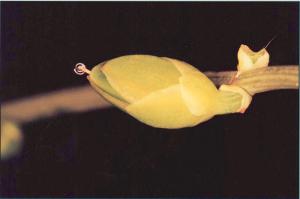
|
Pollination droplet secreted from tip of slender micropylar tube of Ephedra ovule. Pollen adheres to the sticky, sugar-rich droplet, which later retracts to allow pollen to germinate in the pollen chamber adjacent to the female gametophyte.
|
copyright: William E. Friedman, BSA
license: http://images.botany.org/index.html#license |
Image
|
Reproductive Biology

|

|
|
abot81-12
|
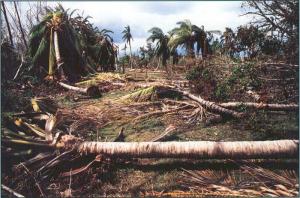
|
Hurricane Andrew (24 August 1992) blew down many large and rare palm trees at Fairchild Tropical Garden, Miami, Florida. This disaster offered a unique opportunity to collect and study the apical buds of these massive monocotyledons as wells as the root and branch wood of a wide range of tropical dicotyledons.
|
copyright: Will Houghton, BSA
license: http://images.botany.org/index.html#license |
Image
|
Structure and Development

|

|
|
abot81-2
|
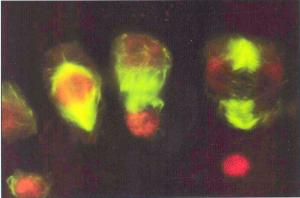
|
Different stages of cell division in marginal cells of the discoid thallus of the charophyte, Coleochaete orbicularis, double stained to show microtubules (green) and nuclei (red).
|
copyright: Roy C. Brown, BSA
license: http://images.botany.org/index.html#license |
Image
|
Physiology, Biochemistry, and Cell

|

|
|
abot81-3
|
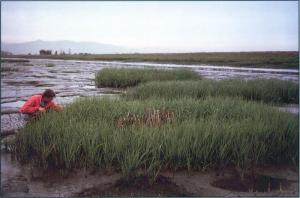
|
Vigorous spring growth of introduced Spartina alterniflora on a mud flat in South San Francisco (California) Bay. This invasive grass threatens to reduce shorebird feeding areas and clog flood control channels. Individual genetic clones, seen as distinct circular patches, have highly variable seed set, which will probably influence the future genetic composition of this population.
|
copyright: Curtis C. Daehler, BSA
license: http://images.botany.org/index.html#license |
Image
|
Reproductive Biology

|

|
|
abot81-4
|
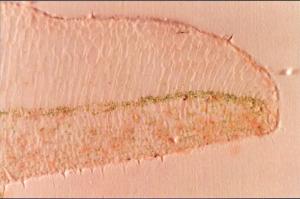
|
Photograph of a tissue print from a mature leaf of Peperomia camptotricha. A thich hand-cut fresh leaf section was pressed onto a nitrocellulose membrance. The resulting untouched print was photographed with side illumination to give a 3-D appearance. Such prints can be used for histochemical studies.
|
copyright: Irwin P. Ting, BSA
license: http://images.botany.org/index.html#license |
Image
|
Physiology, Biochemistry, and Cell

|

|
|
abot81-5
|

|
Distichous phyllotaxy (left) is a distinctive feature of Ravenala madagascariensis (Strelitziaceae) by lemurs in Madagascar: evidence for an archaic coevolutionary system?
|
copyright: W. J. Kress, BSA
license: http://images.botany.org/index.html#license |
Image
|
Reproductive Biology

|

|
|
abot81-6
|
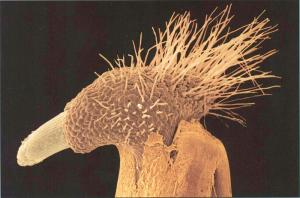
|
The coleorhiza epidermis has root hairlike extensions that elongate (upper right) during radicle emergence (lower left) of perennial ryegrass, Lolium perenne. Artifically colored scanning electron micrograph.
|
copyright: Susan B. Debaene-Gill, BSA
license: http://images.botany.org/index.html#license |
Image
|
Structure and Development

|

|
|
abot81-6a
|
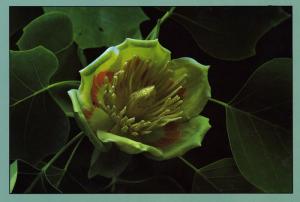
|
Liriodendron tulipifera (Tulip tree) is a characteristic member of the deciduous forests of the eastern United States and is an important timber tree. Some of the largest individuals of this species occur in the southern Appalachian Mountains.
|
copyright: Alan S. Heilman, BSA
license: http://images.botany.org/index.html#license |
Image
|
Unclassified

|

|
|
abot81-7
|
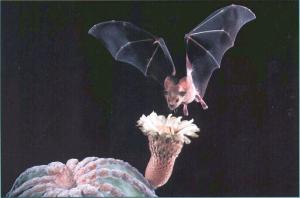
|
A lesser long-nosed bat, Leptonycteris curasoae, approaching a flower of the columnar cactus, Pachycereus pringlei. The abundance of this pollinating bat is a key factor in the maintenance of trioecy in this cactus.
|
copyright: Merlin D. Tuttle, BSA
license: http://images.botany.org/index.html#license |
Image
|
Reproductive Biology

|

|
|
abot81-8
|
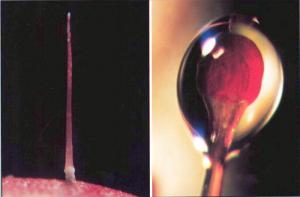
|
Left: Trigger hair of Dionaea muscipula (Venus flytrap). Right: Enlarged view of mucilage-covered tip of Drosera capensis (Cape sundew). Each of these two different structures produces an electrical signal that triggers leaf movements, an apomorphy uniting Dionaea and Drosera with the Droseraceae.
|
copyright: S. E. Williams, BSA
license: http://images.botany.org/index.html#license |
Image
|
Systematics and Evolution

|

|
|
abot81-9
|
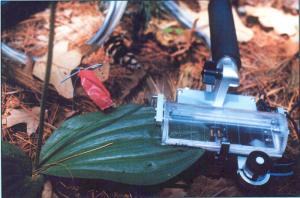
|
Infrared gas analyzer being used in the field to measure the photosynthetic rate of a leaf of pink lady's slipper orchid.
|
copyright: Richard B. Primack, BSA
license: http://images.botany.org/index.html#license |
Image
|
Reproductive Biology

|

|
|
abot82-1
|
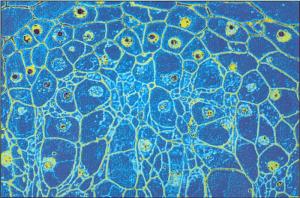
|
Section of chimeral apex of a Balanophora tuber. The composite bundle shown is an integrated mixture of host and parasite cells, which acts as the host/parasite interface. Parasite meristematic cells are large (large nuclei are yellow or blue, with small dots). Small cells with light blue nuclei are host meristematic cells (center of micrograph). Pseudocolorized image.
|
copyright: Ruben Mitchell, BSA
license: http://images.botany.org/index.html#license |
Image
|
Structure and Development

|

|
|
abot82-10
|
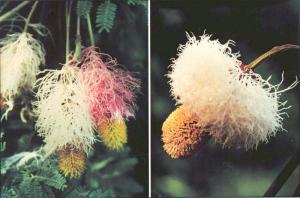
|
Convergent inflorescence morphology in the mimosoid legume genera Parkia (right) and Dichrostachys (left). Parkia nitida Miquel from Ecuador has pendant inflorescences specialized for bat-pollination. The basal flowers are sterile, with white staminodia forming a fringe that overhangs the nectar-producing flowers; the yellow distal flowers are bisexual. Inflorescences of Dichrostachys cinerea (L). Wight and Arnott also have a staminodial fringe, but the staminodia are rose colored when the flowers first open, and gradually change to white postanthesis. These inflorescences also lack specialized nectar-producing flowers, and are presumably entomophilous.
|
copyright: Melissa Luckow, BSA
license: http://images.botany.org/index.html#license |
Image
|
Systematics and Phytogeography

|

|
|
abot82-11
|
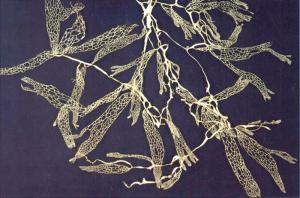
|
Thallus of the lace lichen, Ramalina menziesii, composed of net-like units, which develop by diffuse expansion of perforated tissue.
|
copyright: William B. Sanders, BSA
license: http://images.botany.org/index.html#license |
Image
|
Structure and Development

|

|
|
abot82-12
|
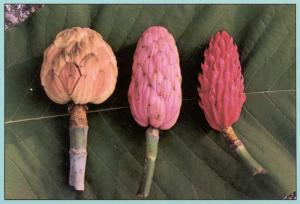
|
Fruit morphology of three Magnolia species in section Rytidospermum from the southeastern U.S.: left, M. macrophylla; middle, M. tripetala; right, M. fraseri.
|
copyright: Yin-Long Qiu, BSA
license: http://images.botany.org/index.html#license |
Image
|
Systematics and Phytogeography

|

|
|
abot82-2
|
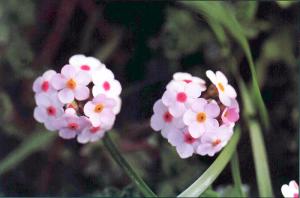
|
The central yellow ring of a young Androsace lanuginosa (Primulaceae) flower turns red over several days, while the rest of the flower remains fresh and unchanged. The color presumably signals the plant's fly pollinators, which visit only rewarding,yellow-phase flowers. Such floral color changes occur in at least 77 families in 33 orders.
|
copyright: Martha R. Weiss, BSA
license: http://images.botany.org/index.html#license |
Image
|
Reproductive Biology

|

|
|
abot82-3
|
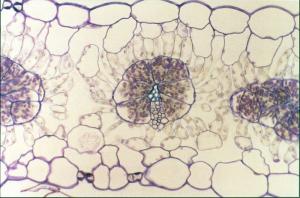
|
Cross section of a mature leaf of the C4 species Atriplex rosea showing the striking structural differentiation
of bundle sheath and mesophyll tissue. During leaf development, a bundle
sheath-specific enzyme, RuBPCase, is expressed, coincident with vein delimitation.
Later, a mesophyll-specific enzyme, PEPCase, accumulates, after formative divisions have ceased.
|
copyright: Nancy G. Dengler, BSA
license: http://images.botany.org/index.html#license |
Image
|
Structure and Development

|

|
|
abot82-4
|
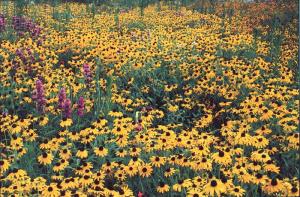
|
The species Rudbeckia hirta used in a wildflower meadow seed mix flowering in July and August in southwest Virginia.
|
copyright: R. E. Lyons, BSA
license: http://images.botany.org/index.html#license |
Image
|
Ecology

|

|
|
abot82-5
|
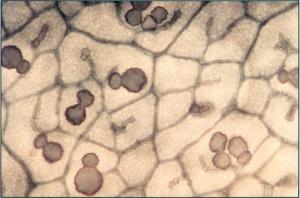
|
Enlarged area of cleared of palo verde (Cercidium floridum). Empty cells (veinlet idioblasts), each interconnected by a perforation platelike gap, are unique to Cercidium, occurring mostly in pairs or clusters abutting terminal veins.
|
copyright: Nels R. Lersten, BSA
license: http://images.botany.org/index.html#license |
Image
|
Structure and Development

|

|
|
abot82-6
|
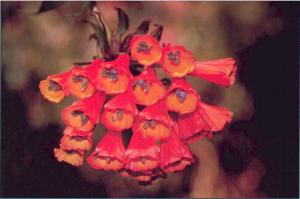
|
A unisexual (early male) umbel of Bomarea acutifolia, a hummingbird-pollinated vine in the mountains of Costa Rica. Following the male phase, each flower continues to produce nectar during a week-long neuter phase and then becomes female. Thus, each umbel is temporally unisexual and opportunities for self-pollination are limited.
|
copyright: -
license: http://images.botany.org/index.html#license |
Image
|
Reproductive Biology

|

|